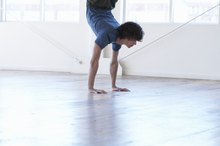What does fact checked mean?
At Healthfully, we strive to deliver objective content that is accurate and up-to-date. Our team periodically reviews articles in order to ensure content quality. The sources cited below consist of evidence from peer-reviewed journals, prominent medical organizations, academic associations, and government data.
- Medline Plus: Numbness and Tingling
- National Diabetes Information Clearinghouse (NDIC): Diabetic Neuropathies: The Nerve Damage of Diabetes
The information contained on this site is for informational purposes only, and should not be used as a substitute for the advice of a professional health care provider. Please check with the appropriate physician regarding health questions and concerns. Although we strive to deliver accurate and up-to-date information, no guarantee to that effect is made.
Numbness in Extremeties After Doing Yoga
In many cases, exercise and yoga effectively reduce the incidence of numbness throughout the body. However, in some cases, such as pinched nerves, particular yoga postures can actually worsen the condition and heighten symptoms of numbness. If you experience numbness in the toes, fingers or anywhere else in the body, immediately stop your yoga practice and consult with your instructor and medical provider. Once you determine the cause of the numbness, you can pursue a modified version of the yoga routine or as you resolve the underlying cause, continue with your yoga practice.
If you are experiencing serious medical symptoms, seek emergency treatment immediately.
Challenging Postures
In some individuals, simply maintaining the same position, whether sitting or standing, results in tingling or numbness 1. If your yoga practice requires you to hold a particular "asana," or yogic position, for an extended period, it's possible that your body simply isn't accustomed to the new pose. Just as your legs can "fall asleep" after you sit cross-legged for a long period, the posture can cause a pins-and-needles sensation for beginners. If you begin to lose feeling and get that prickling sensation, gently come out of the pose and rest. Alert your instructor and, should you resume the pose, stop yourself at the first sign of discomfort; don't wait for pain. Wendy Jardine, a physiotherapist and professor at The Dalhousie University School of Physiotherapy, calls the pins-and-needles sensation a "red flag." While common among beginners, it isn't something to shrug off.
- In some individuals, simply maintaining the same position, whether sitting or standing, results in tingling or numbness 1.
- Just as your legs can "fall asleep" after you sit cross-legged for a long period, the posture can cause a pins-and-needles sensation for beginners.
Possible Underlying Causes
Tingling As a Side Effect of Yoga
Learn More
If you have a tendency to experience numbness outside of yoga as well as after a class, it's possible that an underlying illness or disorder is causing the sensation. Raynaud's disease is a disorder of the blood vessels and circulatory system that affects about 3 to 5 percent of the population, primarily females. The major symptom of the disease is a cold, tingling sensation at the fingers and toes with variations in skin color, from white to blue to red. Numbness of the extremities is also common following cancer treatments such as chemotherapy or radiation. Diabetes can also trigger problems of the nerves, including numbness, tingling or pain, especially in the hands and feet 1. Numbness also can be caused by something as simple as an electrolyte deficiency.
- If you have a tendency to experience numbness outside of yoga as well as after a class, it's possible that an underlying illness or disorder is causing the sensation.
- The major symptom of the disease is a cold, tingling sensation at the fingers and toes with variations in skin color, from white to blue to red.
Simple Solutions
If a gradual approach to more difficult asanas doesn't clear up your symptoms, see if you notice any improvement by wearing socks, massaging your feet or attending a yoga class in a warmer room. It's possible that you're experiencing numbness in your far extremities due to an intolerance to cold. Keeping your extremities at a comfortable temperature can also ameliorate nerve damage, or peripheral neuropathy. If tingling or numbness is caused by an electrolyte imbalance, check that you're hydrating regularly, but not in excess 1. Instead of consuming a large amount of water directly before or after yoga class, get in the habit of drinking plenty of water and juice throughout the day. If the symptom persists, have electrolyte-balancing sports drinks before and after exercise instead of water.
- If a gradual approach to more difficult asanas doesn't clear up your symptoms, see if you notice any improvement by wearing socks, massaging your feet or attending a yoga class in a warmer room.
For Underlying Diseases or Disorders
Does Yoga Cause Numbness and Tingling in Hands?
Learn More
Stress is considered one of the factors that trigger outbreaks of Raynaud's disease. If yoga has not reduced your stress levels, try other options, such as:
- meditation
- counseling or lifestyle changes,
- check whether the numbness persists
For numbness caused by cancer treatments, try massage and physical therapy. If you are diabetic, check that your glucose levels are as close to normal as possible.
Related Articles
References
- Medline Plus: Numbness and Tingling
- "Canadian Living"; Prevent Yoga Injuries; Jane Doucet
- Klein JP. Imaging of progressive weakness or numbness of central or peripheral origin. Handb Clin Neurol. 2016;136:923-37. doi:10.1016/B978-0-444-53486-6.00047-8
- Bracker MD, Ralph LP. The numb arm and hand. Am Fam Physician. 1995;51(1):103-16.
- Wipperman J, Goerl K. Carpal Tunnel Syndrome: Diagnosis and Management. Am Fam Physician. 2016;94(12):993-999.
- Mellion M, Gilchrist JM, De La Monte S. Alcohol-related peripheral neuropathy: nutritional, toxic, or both? Muscle Nerve. 2011;43(3):309-16. doi:10.1002/mus.21946
- Cohen KR, Salbu RL, Frank J, Israel I. Presentation and management of herpes zoster (shingles) in the geriatric population. P T. 2013;38(4):217-27.
- Halperin JJ. Chronic Lyme disease: misconceptions and challenges for patient management. Infect Drug Resist. 2015;8:119-28. doi:10.2147/IDR.S66739
- Okazaki T, Shinagawa S, Mikage H. Vasculitis syndrome-diagnosis and therapy. J Gen Fam Med. 2017;18(2):72-78. doi:10.1002/jgf2.4
- Saint-lary O, Rébois A, Mediouni Z, Descatha A. Carpal tunnel syndrome: primary care and occupational factors. Front Med (Lausanne). 2015;2:28. doi:10.3389/fmed.2015.00028
- England JD, Gronseth GS, Franklin G, et al. Evaluation of Distal Symmetric Polyneuropathy: the Role of Laboratory and Genetic Testing (an Evidence-Based Review). Muscle Nerve 2009; 39:116.
- Gilman, S, Newman, SW. Manter and Gatz's Essentials of Clinical Neuroanatomy and Neurophysiology, 8, FA Davis, Philadelphia 1992.
- Patten J. Neurological Differential Diagnosis, 2nd, Springer, New York 1996.
Resources
Writer Bio
Danielle Hill has been writing, editing and translating since 2005. She has contributed to "Globe Pequot" Barcelona travel guide, "Gulfshore Business Magazine," "Connecting Lines: New Poetry from Mexico" and "The Barcelona Review." She has trained in neuro-linguistic programming and holds a Bachelor of Arts in comparative literature and literary translation from Brown University.









